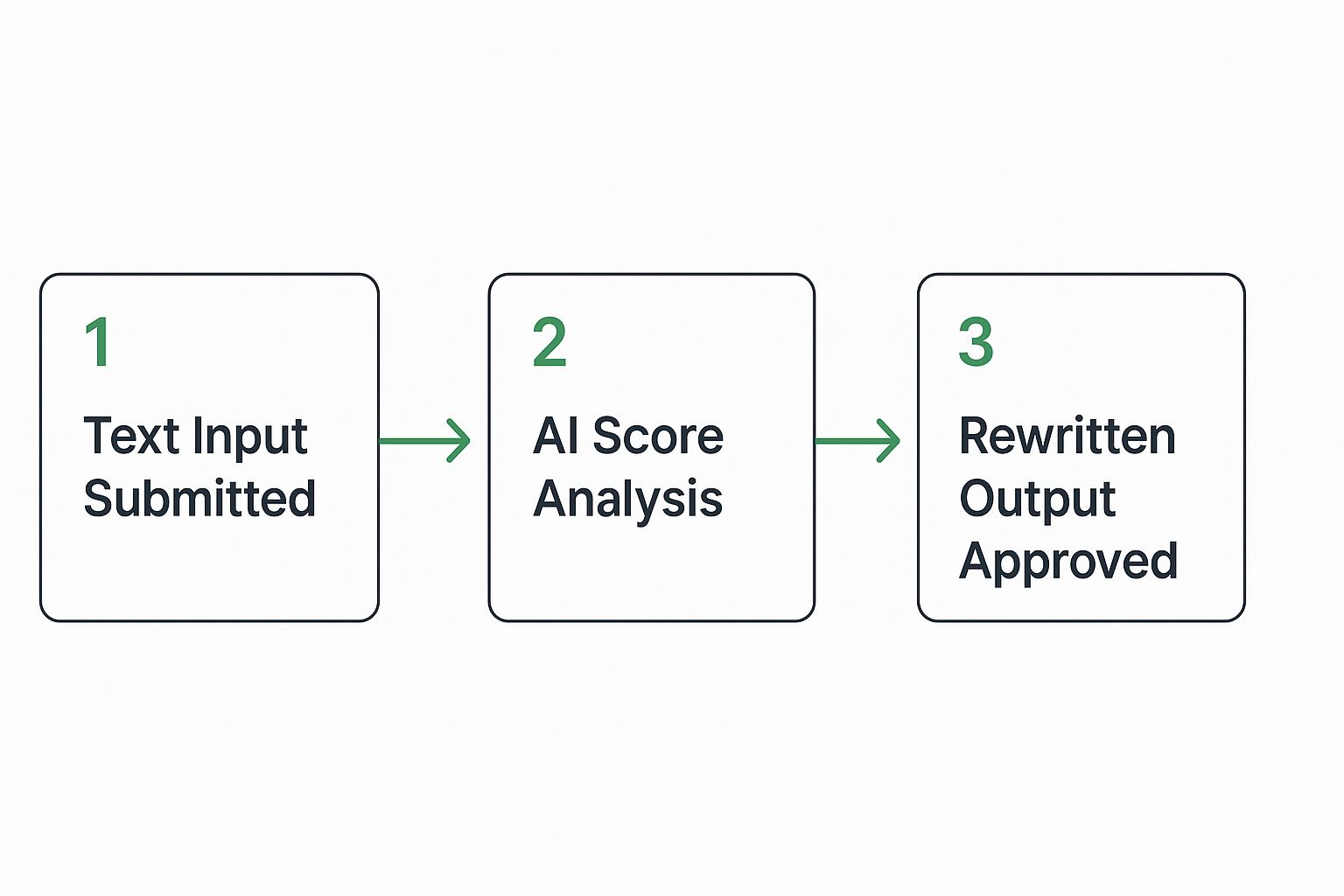
Humanize AI Text with an AI Detector Rewriter
August 13, 2025
So, you’ve started using AI to draft your content. It’s fast, efficient, and gets the basics down. But there's a catch, isn't there? The text often feels… off. A little too perfect, a bit robotic, and missing that human touch. This is where a whole new category of tools comes into play: the AI detector rewriter.
It’s more than just a fancy paraphrasing tool. An AI detector rewriter is specifically built to take that sterile, machine-generated text and breathe life into it. It doesn’t just swap out a few words; it fundamentally alters the writing patterns to bypass AI detection and, more importantly, to make the content genuinely sound like it came from a person.
What Is an AI Detector Rewriter Anyway?
With the explosion of AI content creation tools, making sure your final draft doesn’t scream "written by a robot" has become a huge challenge. Raw AI outputs have tell-tale signs: predictable phrasing, strangely uniform sentence lengths, and a complete lack of personality.
An AI detector rewriter is the solution. Think of it less like a simple thesaurus and more like a skilled editor. It scans the text, identifies those subtle AI fingerprints, and then intelligently reworks it to feel natural and authentic.
The Core Purpose of Rewriting
The real goal here isn't just about fooling an algorithm—it's about making the content better. A great tool, like Natural Write, focuses on a few key things to get this right:
- Improving Readability: It dismantles those monotonous, clunky sentence structures, making the text flow smoothly and keeping your reader engaged.
- Enhancing Authenticity: It weaves in natural-sounding words and a more varied rhythm, which is crucial for building trust with your audience.
- Maintaining Originality: It’s smart enough to preserve the core message and key facts from your original draft, so your brilliant ideas stay front and center.
At its heart, an AI detector rewriter bridges the gap between machine efficiency and human creativity. It takes the speed and power of AI-generated drafts and infuses them with the nuance and flow that only human writing traditionally possesses.
This technology is becoming essential. The global AI content detection software market, which includes these rewriters, is projected to hit USD 1.79 billion in 2025 and is expected to surge to around USD 6.96 billion by 2032. That massive growth is a direct reflection of just how much AI-assisted content is flooding the internet.
To give you a better idea of how this works in practice, let's look at the "AI Detector Rewriter" from a high-level view.
AI Detector Rewriter At A Glance
This table breaks down the essential functions and benefits of using a tool like this.
| Core Function | Primary Goal | Key Benefit |
|---|---|---|
| Analyzes AI-generated text patterns. | Identify robotic sentence structures and phrasing. | Pinpoints exactly why the text feels unnatural. |
| Rewrites text at a structural level. | Create human-like rhythm and flow. | Produces content that is more engaging and readable. |
| Bypasses AI detection algorithms. | Achieve a "human-written" score. | Ensures content is not flagged by AI checkers. |
Ultimately, the process is designed to be simple but powerful. A tool like Natural Write, for instance, first runs your text through its built-in detector to show you a baseline score.

This initial check gives you a clear snapshot of how robotic your text sounds before you even click the button to humanize it. It’s that first step toward turning an AI draft into something you’d be proud to publish.
How AI Detector Rewriters Actually Work
So, how does an AI detector rewriter pull this off? Think of it like a very sharp editor who specializes in spotting the subtle tells of AI-generated content. It's not just looking for typos; it’s analyzing the very DNA of the writing for the kind of patterns that AI detectors are trained to catch.
Those giveaways are often things like super predictable sentence structures, an over-reliance on the same old transition words, and a general lack of rhythm. It just feels flat. If you want a deeper look at what these tools hunt for, you can learn more about how AI detectors work in our guide. A good rewriter, like Natural Write, is built specifically to find these robotic traits and dismantle them.
It then rebuilds the text from the ground up, adding back the nuance that makes writing feel human. This goes way beyond just swapping out a few words for synonyms. The tool actively changes sentence lengths, rephrases ideas with more interesting vocabulary, and adjusts the cadence to make the writing flow naturally.
The Rewriting Journey: From AI to Human
The whole process is a journey, taking a machine-like draft and turning it into something that sounds like it was written by a real person. It’s not a simple copy-and-paste job. It’s a fundamental transformation of style and structure, which usually happens in three key phases.
This graphic lays out the journey from your initial AI text to the polished, human-sounding final version.

As you can see, it all starts with your raw text. From there, the tool analyzes its AI-like qualities and then outputs a refined version that’s ready to go. Let's break down exactly what's happening at each step.
Analysis and Deconstruction: First, you paste in your AI-generated text. The tool immediately gets to work, running a deep analysis to flag any patterns that scream "machine." This includes things like low perplexity (predictable word choices) and low burstiness (sentences that are all the same length).
Structural and Stylistic Reconstruction: This is where the heavy lifting happens. The rewriter doesn't just paraphrase; it completely reconstructs your sentences. It might merge two short, choppy sentences into a single, more elegant one. Or it could take a long, rambling sentence and break it into two punchier points to improve clarity and impact.
Vocabulary and Flow Enhancement: Finally, the tool polishes the text by enriching the vocabulary. It swaps out generic words for more vivid, context-aware alternatives and adjusts the phrasing to make sure everything flows smoothly. The whole point is to produce a piece of writing that reads as if it were thoughtfully crafted by a human, not a machine.
The real magic of an AI detector rewriter is that it understands why a piece of text sounds robotic and surgically fixes those specific issues. Instead of just masking the symptoms with new words, it addresses the root cause: predictable patterns. This deep-level rewrite is what makes the final content truly undetectable and, more importantly, genuinely good to read.
The Real Benefits of Humanizing AI Content

Let's be honest. Using an AI detector rewriter isn't just about trying to sneak past an algorithm. That's a tiny part of the picture. The real win is transforming that sterile, robotic text into something that actually connects with a human being.
Ultimately, you want your content to do a job—whether that’s climbing the Google rankings, building a loyal following, or convincing someone to click "buy." And for that to happen, it needs to be written for people first. When a reader feels that connection, they stick around. They trust what you’re saying. And they’re far more likely to do what you want them to do.
Aligning With What Search Engines Actually Want
Google's own quality guidelines, often boiled down to E-E-A-T (Experience, Expertise, Authoritativeness, and Trustworthiness), are all about rewarding content that genuinely helps people. Raw AI output often stumbles here because it's missing a distinct voice, personal experience, and that spark of genuine authority.
An AI rewriter helps close that gap. By refining the flow, tweaking the vocabulary, and smoothing out the structure, it makes the content feel more engaging and trustworthy. It's a crucial step in making sure your AI-assisted work meets the standards for what makes good website content, which in turn helps you earn better visibility.
This isn't just a fleeting trend. Artificial intelligence is a foundational part of a tech sector projected to hit nearly $748 billion globally in 2025. With AI already in about 77% of the devices we use, its influence is everywhere.
The biggest benefit isn't just bypassing detection; it's elevating your content to a level where it genuinely serves the reader. Humanized text builds trust, fosters engagement, and ultimately drives better business results.
Boosting Engagement and Building Trust
Beyond SEO, the most powerful advantage is how humanized content feels to your audience. Robotic text puts up a wall, making your brand seem cold and distant. But content that flows naturally creates a direct line to your reader.
Here’s where you’ll see the difference:
- Improved Reader Retention: When the writing is smooth and the language is varied, people actually want to read to the end.
- A Stronger Brand Voice: Humanization is your chance to inject your brand’s unique personality, making you far more memorable than the competition.
- Increased Conversions: Trust is the secret ingredient for any transaction. Authentic-sounding content builds that trust, nudging readers to take action.
At the end of the day, the process to https://naturalwrite.com/blog/humanize-ai-text is about restoring the human element that makes communication work. It turns a functional but sterile draft into a powerful tool for connection, ensuring your message isn't just delivered, but actually felt and remembered.
Your Step-by-Step Guide to Using Natural Write
All the theory behind how an AI detector rewriter works is one thing, but seeing it in action makes it real. Let’s walk through the simple, repeatable process using Natural Write. This guide will turn those abstract ideas into a concrete workflow you can start using right away.
The whole process is built for speed and simplicity. You start with a raw AI draft, check its initial score, humanize it with a single click, and then see the dramatic improvement. It’s a fast, effective loop that shows you just how powerful this kind of tool can be.
Step 1: Generate Your Initial Draft
First things first, you need some content. Go ahead and create your draft using any AI writer you like, whether it's ChatGPT, Jasper, or another platform. For this example, let's say we've generated a short paragraph about the importance of digital marketing.
The text you get will probably be factually correct, but it's also likely to have that classic robotic feel—predictable sentences and a total lack of personality. This is our starting point. Our raw material.
Step 2: Get Your Baseline AI Score
Next, copy your AI-generated text and paste it directly into the Natural Write interface. The platform's built-in AI detector will immediately analyze it and give you a baseline score, which represents the probability that the text was written by an AI.
This first check is crucial. It gives you a clear, data-driven starting point and shows you exactly how much your text stands out as machine-generated before you do a thing. It's not uncommon for text straight from an AI to score over 90% AI-detected.
Here’s a look at this exact scenario. A piece of text was pasted in, and the detector returned a high AI score, confirming it sounds robotic.
Seeing that number in black and white is powerful. It pinpoints the problem without any guesswork. Now you have a clear goal: get that score down and make the text sound human.
Step 3: Humanize the Text with One Click
This is where the magic happens. With your text still in the editor, just click the "Humanize" button. Natural Write gets to work instantly, deconstructing the robotic patterns and rewriting the content from the ground up.
This isn't just about swapping out a few synonyms. The tool completely reworks sentence structures, improves word choices, and adjusts the overall flow to mimic how a real person would write.
The goal of this one-click process is pure efficiency. It removes the guesswork and the hours you'd spend manually editing, delivering a structurally and stylistically better draft in seconds. It’s all about getting superior results without the friction.
Step 4: Review and Confirm the New Score
Once the rewrite is done, Natural Write shows you the humanized version. You'll immediately notice it reads more smoothly and sounds way more authentic. But more importantly, the tool automatically re-scans the new text with its AI detector.
The result is almost always a drastically lower AI detection score, often dropping well below the threshold that most detectors would flag. You now have a piece of content that is not only better to read but also ready to be used without worrying about it being marked as AI-generated.
This final step confirms just how effective an AI detector rewriter can be, leaving you with a polished, publish-ready final product.
Practical Use Cases for an AI Rewriter
The real power of an AI detector rewriter clicks into place when you see it working in the wild. Its usefulness goes way beyond just polishing up a blog post; it's a versatile tool for anyone who needs their writing to connect, persuade, and sound truly human. Whether you’re in a university library or a fast-paced marketing agency, the demand for authentic writing is everywhere.
Let’s walk through a few real-world scenarios where this kind of tool makes a huge difference. Each story highlights a common roadblock and shows how a rewriter can be the perfect fix.

For SEO Specialists and Content Creators
Picture an SEO specialist, Sarah, who’s on the hook to deliver ten high-quality articles this week to hit her client’s goals. She uses an AI writer to get the first drafts done, which saves her tons of time on research and outlining. But the output is bland and lacks the authoritative tone she needs to rank for tough keywords.
Instead of burning days on manual edits, she feeds each draft through an AI detector rewriter like Natural Write. The tool immediately gets to work, untangling the robotic sentences and swapping out generic words for more precise ones. Just like that, the content is elevated. From there, Sarah can easily weave in her own expert insights and case studies, creating genuinely helpful articles that feel right to both readers and search engines.
For Students and Academic Integrity
Now think about Leo, a university student using AI to brainstorm and structure a research paper. He’s well aware that just copy-pasting AI text would be a direct violation of his school's academic integrity policy. He uses the AI-generated draft as a jumping-off point but rewrites everything heavily in his own words.
To be absolutely certain his final paper is a true reflection of his own work and doesn't contain any accidental AI footprints, he uses a rewriter as a final check. It helps him polish his phrasing and ensures the text will pass detection tools ethically. If you're a student in a similar spot, our guide on how to make AI writing undetectable while upholding academic standards is a must-read.
For Marketers and Email Campaigns
Over in the marketing department, a team is about to launch a new email campaign. Their AI-generated copy is functional, sure, but it’s completely failing to spark any kind of emotional connection with subscribers. The result? Low open rates and even lower click-throughs. This is a classic problem for teams relying on the top AI marketing software for scale but needing that final human touch.
By running the text through an AI rewriter, they transform the stale, salesy jargon into warm, conversational copy. The rewritten emails sound like they were written by a real person, not an algorithm. This builds trust and gives their engagement metrics a serious boost. It's this kind of adaptability that's fueling rapid growth in the space. The AI writing tools market is projected to be worth $3.53 billion by 2025, with firms in countries like China (67%) and India (61%) leading the charge in adoption.
The common thread here is pretty clear. An AI detector rewriter acts as a bridge. It connects the raw efficiency of machine-generated text with the irreplaceable nuance of human communication, making it an essential part of any modern writing workflow.
Got Questions? We've Got Answers
So, you get what an AI detector rewriter does, but you probably still have some questions floating around. That’s normal. Whenever you bring a new tool into your workflow, it’s smart to think about the practical side of things—ethics, performance, and how to actually use it right.
Let's dive into the questions we hear all the time from writers, marketers, and students dipping their toes into these tools. Getting clear, honest answers is the first step to using them well.
Is Using an AI Rewriter Considered Cheating?
This is a big one, and the answer comes down to one thing: intent.
An AI rewriter isn’t automatically a cheating tool. Think of it more like a super-powered thesaurus or a grammar checker. It’s there to help you refine and polish. The ethics are all in how you use it.
If you’re taking your own ideas or a rough AI-assisted draft and making it better, you’re just improving your work. It only becomes cheating if you’re trying to pass off AI-generated text as your own for, say, a school assignment where that’s against the rules. For content creators and marketers, it's simply part of the modern toolkit for creating higher-quality, more authentic content.
Think of it like this: A professional photographer uses editing software to make their photos pop. They aren't "cheating" at photography; they're using the tools of their trade to deliver the best possible result. An AI rewriter does the same thing for writers.
Will an AI Rewriter Tank My Website's SEO?
This is a common fear, but the reality is just the opposite. A good AI detector rewriter can actually give your SEO a serious boost.
Why? Because Google’s E-E-A-T guidelines are all about rewarding helpful, human-first content. Raw AI text, with its predictable patterns and generic feel, often struggles to meet that standard. It can sound flat and uninspired.
A rewriter like Natural Write injects the nuance, unique phrasing, and natural rhythm that search engines are looking for. By making your content more engaging for a human reader, you’re sending all the right signals to Google and improving its chances to rank.
Can AI Detectors Still Flag Rewritten Content?
While top-tier rewriters are incredibly good at what they do, no tool can guarantee a 0% AI score 100% of the time. Detection tools are always getting smarter, so it's a bit of a cat-and-mouse game.
That said, a quality rewriter makes detection much less likely. It works by fundamentally altering the building blocks of the text—sentence structure, word choice, and flow—to mirror how a person actually writes.
For that final touch of authenticity, it’s always a good idea to:
- Give the final text a quick read-through yourself.
- Tweak a few phrases to add your personal voice.
- Drop in a personal story or a specific example.
That last little bit of human oversight is what makes the content truly undetectable and genuinely yours.
What's the Difference Between an AI Rewriter and an Article Spinner?
Night and day. It's a massive difference, and it’s crucial to understand why.
Article Spinners: These are old-school tools that just find-and-replace words with synonyms. The result is often clunky, nonsensical text that’s painfully obvious to both people and modern algorithms. It just doesn't work anymore.
AI Rewriters: An advanced AI detector rewriter is way more sophisticated. It uses powerful language models to understand the meaning and context of your text. Then, it rebuilds it from the ground up with fresh sentence structures and a more natural vocabulary.
A rewriter’s goal is to preserve your core message while completely changing the style of the writing to feel human—not just swapping out a few words.
Ready to turn those robotic AI drafts into content that truly connects? Experience the difference for yourself. Try Natural Write for free and see how easy it is to humanize your text with a single click. Visit https://naturalwrite.com to get started now.


